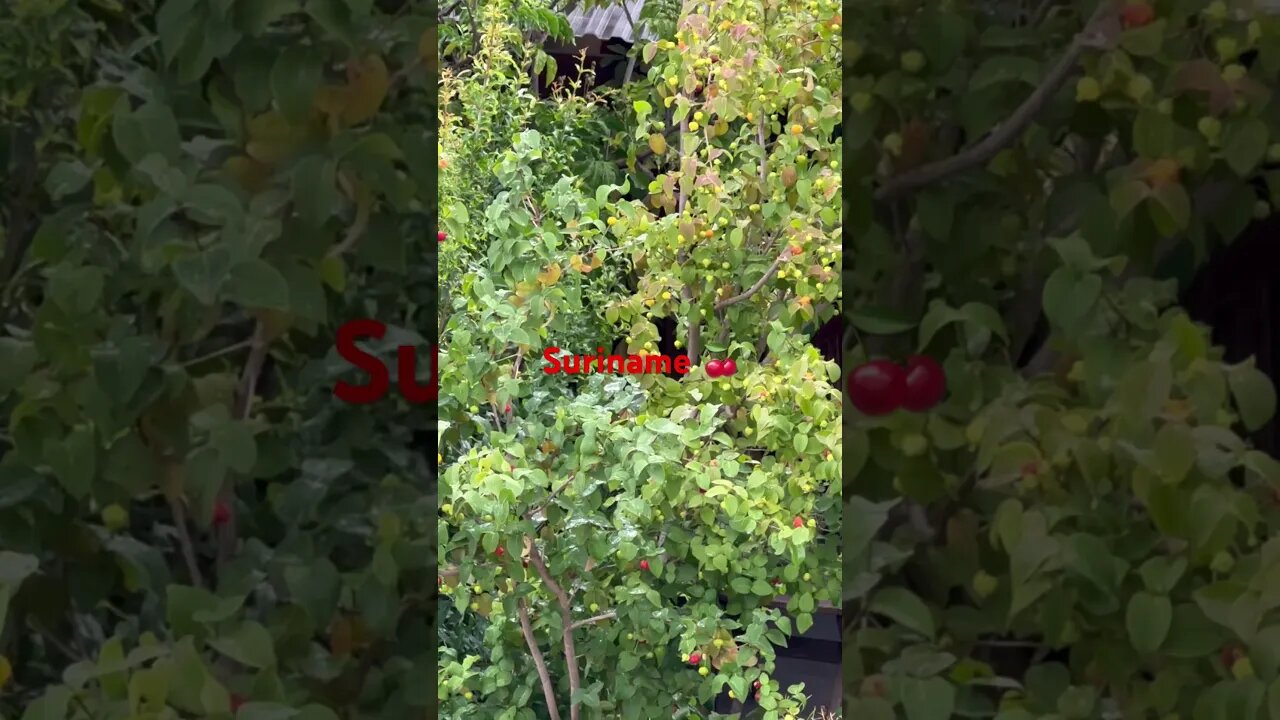Premium Only Content

Everything about the Suriname Cherry Tree
#surinamecherry #cherrytree #cheries #surinametree
The Suriname cherry tree, also known as Eugenia uniflora or pitanga, is a tropical fruit tree native to the northern parts of South America, including Suriname, Brazil, and Venezuela. Here is some information about the Suriname cherry tree:
Description: The Suriname cherry tree is an evergreen shrub or small tree that typically grows up to 20 feet (6 meters) in height. It has dense foliage with glossy, elliptical leaves that are about 2-4 inches long.
Fruit: The tree produces small, round fruit known as Suriname cherries. The fruit is about the size of a cherry or small plum, measuring approximately 1 inch in diameter. When ripe, the fruit can vary in color from bright red to dark purple.
Flavor: Suriname cherries have a unique taste that is both sweet and tart. The flavor is often described as a combination of cherry, strawberry, and pineapple. The fruit is juicy and can be eaten fresh or used in various culinary preparations.
Nutritional Value: Suriname cherries are rich in antioxidants, particularly vitamin C. They also contain significant amounts of vitamin A, iron, calcium, and dietary fiber. The fruit is considered to be highly nutritious and has several health benefits.
Medicinal Uses: In traditional medicine, different parts of the Suriname cherry tree are used to treat various ailments. The fruit is believed to have antioxidant and anti-inflammatory properties, and it is used to boost the immune system, aid digestion, and promote healthy skin.
Culinary Applications: Suriname cherries are consumed in multiple ways. They can be eaten fresh as a snack or used to make juices, jams, jellies, and desserts like pies and ice creams. The fruit's tangy flavor also makes it a popular ingredient in sauces, marinades, and cocktails.
Growing Conditions: Suriname cherry trees thrive in tropical and subtropical regions. They prefer well-drained soil and full sun exposure. The tree is adaptable and can tolerate a variety of soil types. It is also drought-tolerant once established.
Propagation: Suriname cherry trees can be propagated from seeds or cuttings. Seeds take around 3-4 weeks to germinate, and the young plants can be transplanted once they have developed a few leaves. Cuttings can be taken from mature branches and rooted in a suitable growing medium.
Ornamental Value: In addition to its fruit-bearing capabilities, the Suriname cherry tree is often cultivated for its attractive appearance. The glossy leaves, dense foliage, and colorful fruit make it a visually appealing choice for gardens and landscapes.
Environmental Impact: Suriname cherry trees can have invasive tendencies in some regions, particularly in Florida and Hawaii. Their ability to spread rapidly and produce fruit year-round has led to concerns about their impact on native ecosystems. It is important to manage and control their growth in areas where they are considered invasive.
Please note that while the information provided is based on general knowledge, specific details about the Suriname cherry tree may vary depending on regional factors and individual cultivation practices.
Regenerate response
Screenshot
-
 LIVE
LIVE
LFA TV
2 hours agoLFA TV ALL DAY STREAM - WEDNESDAY 8/27/25
10,724 watching -
 1:22:55
1:22:55
Game On!
17 hours ago $1.62 earnedBREAKING NFL NEWS: Taylor Swift and Travis Kelce Are Engaged!
21.1K8 -
 41:04
41:04
Coin Stories with Natalie Brunell
1 day agoCooking, Culture & Crypto: Norma Chu’s Food Empire Turns Bitcoin Treasury
18.3K -
 LIVE
LIVE
JuicyJohns
30 minutes ago🟢#1 REBIRTH PLAYER 10.2+ KD🟢
36 watching -
 1:21:19
1:21:19
JULIE GREEN MINISTRIES
2 hours agoLIVE WITH JULIE
31.7K123 -
 LIVE
LIVE
GritsGG
52 minutes agoWin Streaking! Most Wins 3485+ 🧠
17 watching -
 1:02:09
1:02:09
The Confessionals
21 hours agoThe Supernatural Proof You Can’t Ignore (When Angels and Demons Showed Up) | Lee Strobel
30.5K22 -
 15:24
15:24
Degenerate Jay
21 hours ago $0.76 earned5 Best Moments In Batman: Arkham Asylum
14K -
 12:24
12:24
The Shannon Joy Show
15 hours ago🔥From Flock Cameras to Palantir: America’s Expanding Digital Cage🔥
11.8K2 -
 2:03:45
2:03:45
BEK TV
1 day agoTrent Loos in the Morning - 8/27/2025
12.2K